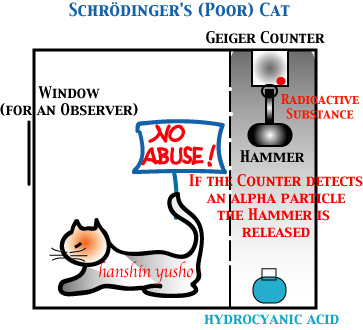

Schroedinger's Cat
In 1935, the paper by Einstein, Podolsky, and Rosen appeared in the Physical Review 47. This stimulated Erwin Schroedinger, and the result was his three-part paper in Die Naturwissenschaften 23 (1935) , "Die gegenwaertige Situation in der Quantenmechanik". Its English translation is included in Wheeler & Zurek volume. Of course, this is the source of Schroedinger's Cat, which appears in section 5.
But serious misgivings arise if one notices that the uncertainty affects macroscopically tangible and visible things, for which the term "blurring" seems simply wrong. The state of a radioactive nucleus is presumably blurred in such degree and fashion that neither the instant of decay nor the direction, in which the emitted α-particles leaves the nucleus, is well-established. Inside the nucleus, blurring doesn't bother us. ...[goes on to luminescent screen and cloud chamber etc.]
One can even set up quite ridiculous cases. A cat is penned up in a steel chamber, along with the following diabolical device (which must be secured against direct interference by the cat): in a Geiger counter there is a tiny bit of radioactive substance, so small, that perhaps in the course of one hour one of the atoms decays, but also with equal probability, perhaps none; if it happens, the counter tube discharges and through a relay releases a hammer which shatters a small flask of hydrocyanic acid. If one has left this entire system to itself for an hour, one would say that the cat still lives if meanwhile no atom has decayed. The first atomic decay would have poisoned it. The ψ-function of the entire system would express this by having in it the living and the dead cat (pardon the expression) mixed or smeared out in equal parts.
It is typical of these cases that an indeterminacy originally restricted to the atomic domain becomes transformed into macroscopic indeterminacy, which can then be resolved by direct observation. That prevents us from so naively accepting as valid a "blurred model" for representing reality. (Wheeler and Zurek 1983, 156-7).

The italicized word "resolve" means something like this in this context. Suppose an observer is going to open the window in order to see whether the poor cat is alive or dead. Until the observer opens the window and sees, the ψ-function of the entire system is in a superposition state: conveniently expressed as (live cat + dead cat); but by the very observation, this wave packet (superposition) collapses and becomes either "live cat" or "dead cat". Schroedinger is asking: does the superposition (live cat + dead cat) make sense, even if we allow such a "blurred state" to atoms?
See also Schroedinger Note.
Bohr, N. (1958) Essays 1933-1957 On Atomic Physics and Human Knowledge
Tomonaga, S. (1997) 量子力学 II(第2版)、みすず書房。
Wheeler, J. A., and Zurek, W. H., ed. (1983) Quantum Theory and Measurement, Princeton University Press.
See also a useful site on Microphysics, at Kyushu University: http://www2.kutl.kyushu-u.ac.jp/seminar/MicroWorld/MicroWorld.html